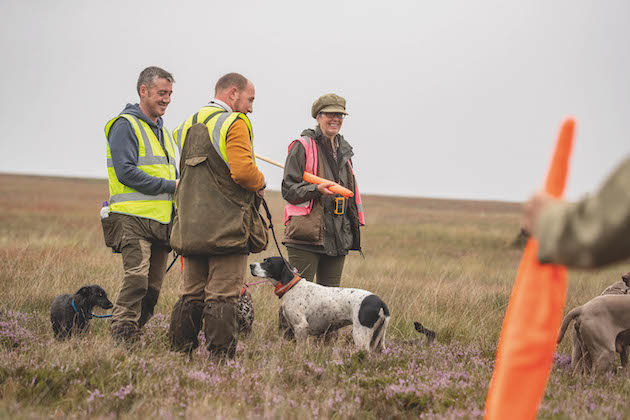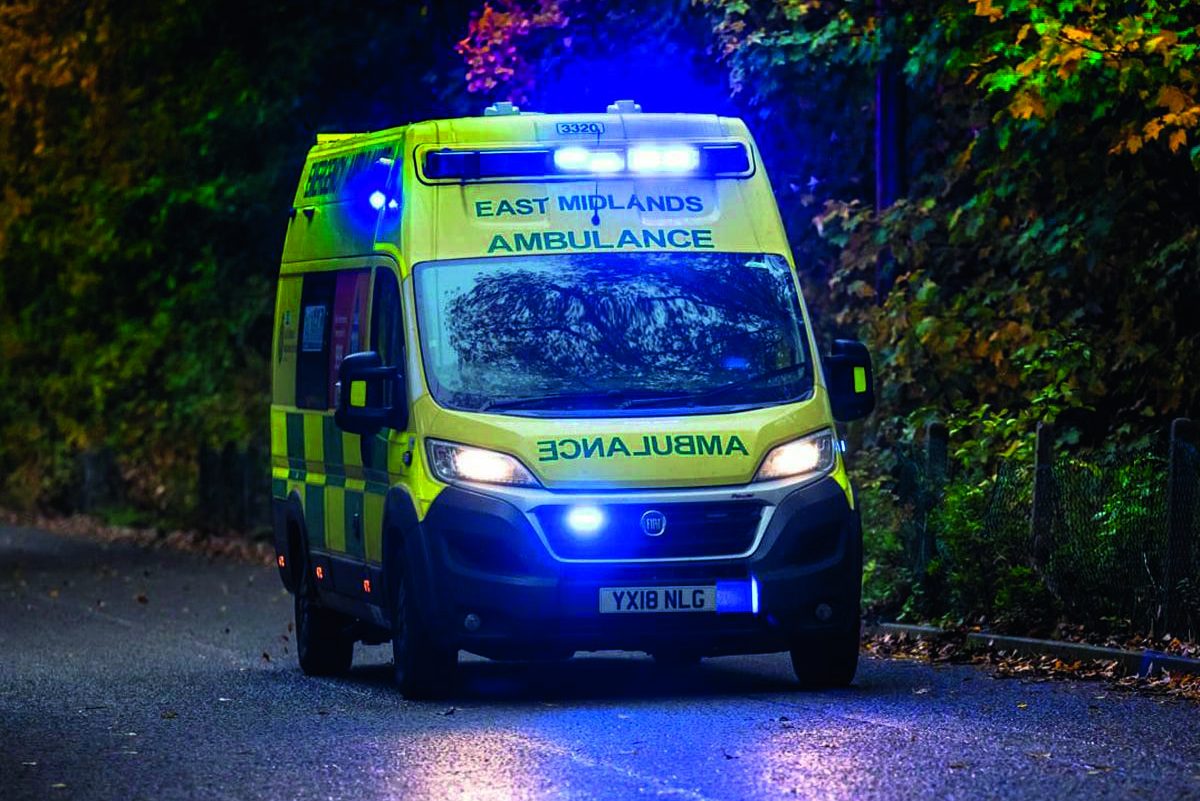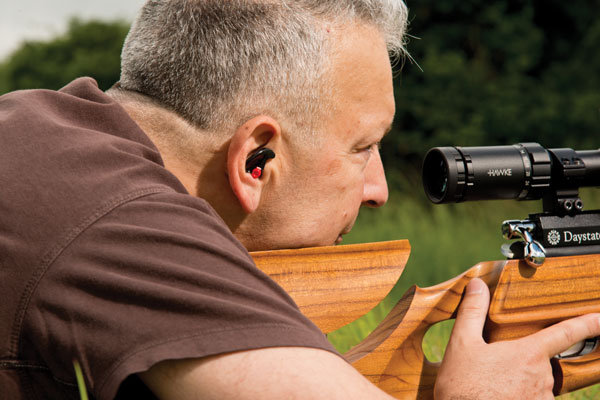Is high vis clothing the future for beaters in the UK?
Hi-vis is credited with a drop in hunting accidents in the US and Matt Cross believes it is only a matter of time before it is adopted in the UK

Beaters remaining cheery after the first drive
“Boy looks like he has ram-raided John Norris.” The ‘boy’ in question was in fact a young man, but the rest of my fellow beater’s comment was acerbically accurate. The individual in question was wearing wellies with buckles, tweed breeks, a checked shirt with a tie and gilet with contrasting piping.
There is a range of beater sartorial styles. At one extreme, you have those who like to flash a bit of Schöffel and Musto. At the other extreme are those who buy their clothing from a feed merchant. In between, there are army-surplus wearers, the camo fans, the Dunlop wellie evangelists, the Jack Pyke crew and the smock men. But one thing you won’t see is anyone wearing hi-vis. (Read our list of best clothing for beaters.)
By contrast, I recently went to a chipboard factory. If you are interested in chipboard, which I am, it was really quite fascinating. A large sign on the gate told me: “Hi-vis must be worn at all locations on site.”
As soon as I stepped through the gate, a speaker buzzed angrily at me and a female voice told me politely but firmly: “Please take a vest from the box and put it on.” After an amicable chat in a meeting room, the other engineered-wood fans and I were issued with protective eyewear and hearing protection before being taken on a tour.
But here is the odd bit; there was no point on my highly visible tour of wood shredders, log yards and board presses when I felt in the least bit at risk, nothing where I thought, “this is a bit shady”.

Stand out in the undergrowth with the Seeland Force advanced jacket
Now, contrast that to beating. Recently, writing about foreign Guns, I mentioned watching an American gent on his peg, gun horizontal, waist high and unbroken, turning from side to side. At the time, I was well within range, clad in green and was crawling through a patch of blackthorn. If he had looked hard, he might have seen me, but the chance of me catching his eye was close to zero.
Hi-vis vests aren’t the answer to poor gun handling, but I have no doubt that in that specific situation, a big splodge of orange would have made me safer. I
It is not only chipboard factories; any significant building site will have a mandatory hi-vis rule. Forestry workers, mechanics, lollipop persons, police officers, cyclists and nursery children out for walks are all now decked out in shades of yellow and orange.
At times, it verges on the ridiculous. When a man from the council came to check the house we had built, he put on his hi-vis and hard hat to walk round the living room where my children were playing. He got dressed up because, according to his rules, it was a building site, so he had to wear all the safety gear. Happily, he was not struck by any falling soft toys or run over by the rocking horse.

Beaters can be identified by white flags but hi-vis clothing is becoming more common
Silly excesses aside, hi-vis is a valuable tool for keeping people safe. Anyone who has passed a cyclist in yellow on the road will know the difference it can make. In the right situation, it does definitely make hunting sports safer.
During Mississippi’s 1972-73 season, 80 hunters were shot, 34 of them fatally. During a single day three hunters with gunshot wounds were brought into Forrest General Hospital in Hattiesburg. Only one of them survived. Mississippi is not a state that is famed for being overly troubled about its residents shooting each other but, even for Mississippi, 80 was too many and something had to be done.

the wearing of orange hats and tops is credited with cutting the number of hunting accidents in parts of the US
Bright colours
The solution was to mandate the wearing of orange hats. The next season, uptake of the mandatory orange hat was poor, but the number of incidents and deaths still fell. When the requirement to wear 500 square inches of orange was introduced, deaths fell again. Now you are more likely to be injured falling out of a tree stand in Mississippi than to be shot.
Hi-vis clothing is not the answer to everything. In France recently, one duck hunter shot another across a pond. Hi-vis did not prevent that. Nor did the hi-vis a hunter was wearing stop his bullet ricocheting off a road and hitting a passing motorist. The driver died of his injuries. A close analysis of ‘human factors’ in American hunting accidents found that hunters wearing blaze orange were still occasionally mistaken for deer and shot. The shooter, desperate to get their buck, saw what they wanted to see and ignored the orange.

Though beaters carry flags, they tend to wear a mix of greens and browns
Mistaken identity
The way we organise hunting in the UK is, of course, quite different. The big issue in Mississippi is deer hunters mistaking one another for deer. The chance of two British deer stalkers unexpectedly being on the same ground is quite slim —and if you stumbled across someone you didn’t know shooting your pheasants you would probably call the police.
Then we have that peculiarly British beast, the driven game shoot — and it offers many occasions on which a person with a gun will be in close proximity to a person they cannot easily see. I doubt many beaters are mistaken for pheasants; much more likely is that they are simply not spotted in the heat of the moment.
It is known to two-wheeled road users as a SMIDSY — Sorry Mate, I Didn’t See You. Surely hi-vis could help with that? For most beaters, the key tool for making sure they are seen is their flag and the combination of white and movement is very eye-catching. But what about those drives where flagging is discouraged or impractical, or what about the beater who forgets their flag or gets a bit lazy?
Nearly every beater on every shoot, whether they are a fan of Musto or Guy Cotten, will be decked out in a mixture of green and brown. There is more justification for that than fitting in with the normal shooting aesthetic. If the experiences of American shooters are anything to go by, bright orange does alarm pheasants. Regardless of whether pheasants see orange in the same way we do, they do not like it.

Make yourself seen in a bright orange Seeland Ian reversible beanie hat
Its alarming effect on pheasants is not the only argument against hi-vis on the beating line. Accidents do happen but they are rare, and serious accidents rarer still. So it is fair to ask what problem hi-vis would actually solve. But here’s the truth — it’s coming. Like it or not, hi-vis is coming to a beating line near you very soon. It’s coming because it is so ubiquitous everywhere else, it has become an expectation for anyone who is at any kind of risk.
Insurance risk
One day a beater is going to get seriously hurt and the loss adjuster from the insurance company is going to say something like: “So let me get this straight, you have a line of people with guns and another line of people walk to within range of those guns and the people walking towards the guns wear clothing that is actually chosen to be unobtrusive and to blend into the background? Why on earth would we insure that?”

Stay warm and visible with the Beretta Gascon jacket in orange Realtree
And when that happens, we’d better hope John Norris buys in a stock of blaze orange, but if they don’t I’m sure the local feed merchant will have something suitable.








